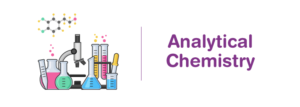Analytical Chemistry
What is Analytical Chemistry?
Analytical chemistry is the branch of chemistry that deals with the analysis of different substances.
Analytical chemistry encompasses the separation, identification, and quantification of matter, utilizing both classical and modern methods, often employing scientific instruments.
Key methods within analytical chemistry include:
- Separation: This process involves isolating the desired chemical species from a mixture, enabling further analysis of individual components.
- Identification: Through qualitative analysis, analytical chemists identify the specific substances present in a sample, often employing techniques such as spectroscopy, chromatography, and mass spectrometry.
- Quantification: Quantitative analysis determines the concentration or amount of the analyte in a given sample, providing numerical data on the composition of the mixture.
While modern analytical chemistry heavily relies on sophisticated instruments, the underlying principles are rooted in traditional techniques. These traditional methods laid the foundation for the development of modern instrumentation, which has significantly enhanced the accuracy, sensitivity, and efficiency of analytical processes. Therefore, while technology has advanced, the fundamental principles of analytical chemistry remain essential for understanding and interpreting experimental results.
Methods Used in Analytical Chemistry
The methods used to determine the identity and the quantity of the analytes in the field of analytical chemistry can be broadly divided into classical and instrumental methods.
1. Classical Methods
Classical methods play a crucial role in qualitative and quantitative analysis in analytical chemistry. Here are some examples:
- Acid Test for Gold: This classical method involves applying nitric acid to a sample suspected of containing gold. If the sample contains gold, it will not react with the acid, indicating its presence.
- Kastle-Meyer Test: This method employs phenolphthalein as an indicator to detect the presence of hemoglobin in a sample, typically used in forensic analysis to identify bloodstains.
- Flame Tests: Flame tests are utilized to identify the presence of specific elements in a sample by observing the characteristic color emitted when the sample is introduced into a flame. Different elements produce distinct colors.
- Gravimetric Analysis: Gravimetric analysis is a classical quantitative method used to determine the amount of a substance in a sample based on the measurement of mass. For example, in determining the water content of a hydrate, the sample is heated to remove the water, and the loss in mass is measured.
- Volumetric Analysis (Titration): Titration is a widely used classical quantitative method where a solution of known concentration (titrant) is added incrementally to a solution of the analyte until the reaction reaches completion (equivalence point). The volume of titrant required to reach the equivalence point is used to calculate the concentration of the analyte.
These classical methods provide valuable tools for both qualitative and quantitative analysis, offering simplicity, reliability, and cost-effectiveness in various analytical applications.
2. Instrumental Methods
Spectroscopy involves the measurement of the interaction between electromagnetic radiation and the atoms or molecules in a sample. This technique provides valuable information about the structure, composition, and properties of substances.
Mass spectrometry, on the other hand, utilizes electric and magnetic fields to measure the ratio of the mass of a molecule to its charge. This method is widely used for identifying and quantifying compounds based on their mass-to-charge ratio.
Electrochemical analysis is a common instrumental method in analytical chemistry, where the analyte is placed in an electrochemical cell, and the voltage or current flowing through it is measured. This method is used to determine the concentration of analytes, study redox reactions, and investigate corrosion processes.
Calorimetry is another analytical technique that studies the interaction between the analyte and energy in the form of heat. A calorimeter is an instrument used to measure the heat of a chemical reaction, providing insights into reaction kinetics, thermodynamics, and energy changes.
Furthermore, the field of bioanalytical chemistry utilizes these analytical techniques for biological measurements. Bioanalytical chemistry focuses on studying biological samples such as proteins, enzymes, DNA, and drugs, employing analytical methods to understand their structure, function, and interactions within living systems.
Branches of Analytical Chemistry
Two sub-branches come under analytical chemistry namely quantitative analysis and qualitative analysis which can be explained as follows. These two methods form the backbone of many educational labs of analytical chemistry.
1. Quantitative Analysis
Quantitative Analysis is indeed a method used to determine the absolute or relative quantity of one or more substances present in a sample or compound.
In the process of quantitative analysis, chemists often utilize qualitative methods initially to identify the type of compound present in the sample. Once the compound is identified, quantitative analysis techniques are employed to precisely determine the amount or concentration of the compound in the sample.
Some common quantitative analysis techniques include:
1. Gravimetric Analysis: This method involves the measurement of mass to determine the quantity of a substance present in a sample. It relies on the formation of a precipitate or a change in mass due to a chemical reaction to quantify the analyte.
2. Volumetric Analysis (Titration): In titration, a solution of known concentration (titrant) is added to the sample until the reaction reaches completion (equivalence point). The volume of titrant required to reach the equivalence point is used to calculate the concentration of the analyte.
These quantitative analysis techniques provide precise and accurate measurements of the amount or concentration of substances in a sample, contributing to various fields such as chemistry, environmental science, pharmaceuticals, and more.
2. Qualitative Analysis
Qualitative analysis focuses on determining the presence or absence of certain substances or properties in a sample without quantifying the amount or concentration. This method is particularly useful for identifying compounds or characteristics based on their qualitative properties rather than their quantities.
Observing chemical reactions for changes such as color, precipitation, gas evolution, or temperature change is a common qualitative analysis technique. Other methods include chemical tests, flame tests, and various spectroscopic techniques.
In salt analysis, for instance, qualitative analysis methods are employed to identify the cations and anions present in an inorganic salt sample. By performing specific chemical tests or observing characteristic reactions, chemists can determine the identity of the ions in the salt.
Overall, qualitative analysis provides valuable information about the composition and properties of substances, aiding in identification and characterization processes in various scientific and industrial applications.
Importance of Analytical Chemistry
Analytical chemistry is a fundamental subject taught in schools and colleges due to its significance in various industries and scientific fields. While the principles and techniques of analytical chemistry are widely taught and studied, the practical applications often occur in specialized settings such as pharmaceutical industries, food factories, chemical industries, agricultural industries, and scientific laboratories.
The applications of analytical chemistry in these industries are diverse and essential. For example:
- Pharmaceutical industries utilize analytical chemistry for drug development, quality control, and regulatory compliance. Techniques such as chromatography, spectroscopy, and mass spectrometry are commonly employed to analyze drug compounds, impurities, and formulations.
- Food factories rely on analytical chemistry for quality control, safety testing, and nutritional analysis of food products. Analytical techniques help ensure that food products meet regulatory standards and are safe for consumption.
- Chemical industries utilize analytical chemistry for process monitoring, product characterization, and environmental analysis. Analytical methods are crucial for ensuring the quality and purity of chemical products and identifying potential environmental pollutants.
- Agricultural industries employ analytical chemistry for soil testing, pesticide analysis, and food quality assessment. Analytical techniques help optimize agricultural practices, ensure crop productivity, and minimize environmental impact.
- Scientific laboratories across various disciplines utilize analytical chemistry for research, experimentation, and data analysis. Analytical techniques enable scientists to study chemical processes, identify unknown substances, and advance scientific knowledge.
While analytical chemistry tools and instruments may be expensive and require specialized expertise to operate, their applications play a vital role in ensuring the safety, quality, and efficiency of products and processes in diverse industries.
Applications of Analytical Chemistry
Analytical chemistry finds numerous important applications across various fields. Here are some examples:
- Determining Shelf Lives of Medicines: Analytical chemistry plays a crucial role in pharmaceutical industries by assessing the stability and shelf life of medications. Through analytical techniques, such as chromatography and spectroscopy, the degradation of active pharmaceutical ingredients over time can be monitored, ensuring the efficacy and safety of drugs.
- Adulterant Detection in Drugs: Analytical chemistry is employed to detect the presence of adulterants or contaminants in drugs and pharmaceutical products. By analyzing drug samples using techniques like chromatography and mass spectrometry, chemists can identify impurities or unauthorized substances, ensuring the quality and safety of medications.
- Soil Testing for Nutrient Levels: Analytical chemistry is utilized in agriculture to assess soil fertility and nutrient levels. Soil samples are analyzed to determine the concentrations of essential minerals and nutrients necessary for plant growth. This information helps farmers optimize fertilizer application and soil management practices to enhance crop productivity and sustainability.
- Chromatographic Blood Analysis: Chromatography, a key analytical technique, is used in forensic and medical laboratories to analyze blood samples. By separating the components of blood, such as drugs, metabolites, and biomarkers, chromatography enables the identification and quantification of substances present in the bloodstream. This information is valuable in forensic investigations, clinical diagnostics, and medical research.

- Food Safety: Analytical chemistry plays a crucial role in ensuring food safety by analyzing food samples for pesticide residues, contaminants, and adulterants. By employing techniques such as chromatography, mass spectrometry, and spectroscopy, chemists can accurately determine the concentration of harmful substances in food products, safeguarding public health.
- Medicine: In the medical field, analytical chemistry is utilized for diagnosing and monitoring diseases by testing biological samples such as blood, urine, and tissues. It enables the quantification of biomarkers, such as cholesterol and glucose levels, aiding in the management of conditions like diabetes and cardiovascular disease.
- Forensic Science: Analytical chemistry is integral to forensic investigations, where it is used to analyze evidence such as blood, saliva, hair, and fibers. By employing techniques like chromatography, mass spectrometry, and DNA analysis, forensic scientists can identify and analyze trace evidence, helping to solve crimes and establish facts in legal proceedings.
- Clinical Analysis: In clinical laboratories, analytical chemistry is employed for diagnosing and monitoring medical conditions through the analysis of patient samples. It enables the measurement of various analytes, including hormones, drugs, and metabolites, providing valuable information for patient care and treatment decisions.
- Environmental Analysis: Analytical chemistry plays a vital role in environmental monitoring and pollution control by analyzing air, water, soil, and biological samples for pollutants and contaminants. By employing advanced analytical techniques, environmental chemists can assess environmental quality, identify sources of pollution, and mitigate environmental risks.
In summary, analytical chemistry is a diverse and interdisciplinary field with wide-ranging applications in ensuring food safety, advancing healthcare, solving crimes, protecting the environment, and improving overall quality of life. Its contributions are essential in addressing contemporary challenges and advancing scientific knowledge across various domains.

